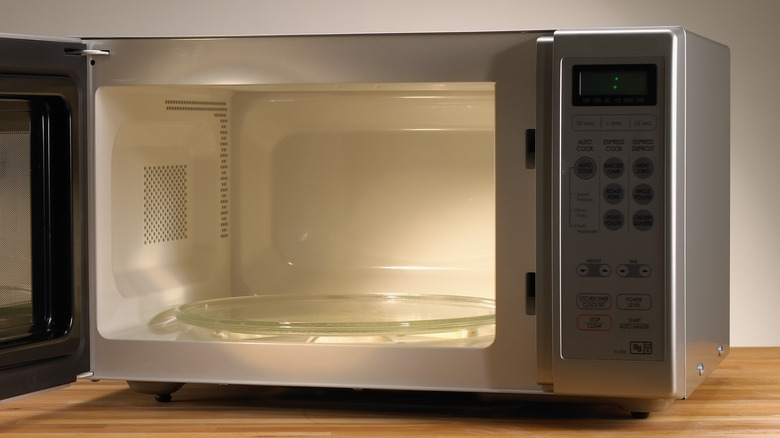You Can Cook Meatloaf In The Microwave, But Should You?
"Wow, this meatloaf is great," says your Aunt Enda. "Thanks," you say, "I made it in the microwave." There's horror, screaming...maybe just a pregnant pause before a monosyllabic "Wow." For sure, this is a social taboo. But, on the other hand, Chef David Chang swears by microwaved mashed potatoes and gravy. But, when it comes to meatloaf, that same ingenuity feels a little sacrilegious (make that "unholy").
The microwave provides convenience and speed, and technically, it is a tool capable of cooking a 9x5 glass loaf pan of ground beef. So, yes, you can cook a meatloaf in the microwave, but you probably shouldn't.
Microwaves work by sending penetrating "microwaves" into food, generating heat that cooks food from the inside out, which could be a good fit for your meatloaf ... in theory. The story can be a little different in execution. Have you ever tried microwaving a frozen dinner only to find the outside blazing hot and the inside still icy? Yeah...
Your biggest enemy here is uneven cooking, and microwaving a plate of ground beef for tacos is pretty different from slamming a solid brick of ground beef in the microwave and hoping for the best. Admittedly, this writer has never personally tried cooking meatloaf in the microwave, but in my all-holy summation, it seems like a good way to waste ingredients and create a lasting food aversion to a beloved dish. Still, if you're going to do it, do it right (or, as "right" as possible here).
A few tips for the road...but you should take a different route
According to USDA, if a food thermometer inserted into the center of the meatloaf reads 160 degrees Fahrenheit, it's safe to eat, but other sources say 165 degrees Fahrenheit is better suited for a solid brick of meat. Around 10 to 15 minutes on high should do the trick, but you'll know the meatloaf is finished cooking when the inside is no longer pink and there's no blood in the cooking juices. No matter what, defrost your beef first and consider softening the veggies separately (which can also be done in the microwave).
To aid in a more even cook, a microwave-safe bundt pan is actually a better-suited tool than a loaf pan, as it'll increase the surface area of your meatloaf and stave off a potential raw center. If you're going this route, you can always take the meatloaf out of the Bundt pan, slice it up, and arrange the pieces on a serving tray. Dinner party guests will be none the wiser (especially if it's surrounded by a cornucopia of yummy side dishes). Still, perhaps it's best to save the microwave for popcorn and keep your meatloaf in the oven where it belongs.

